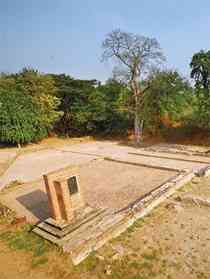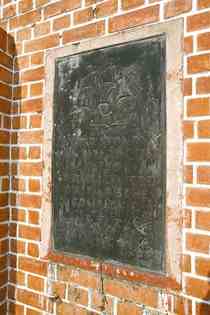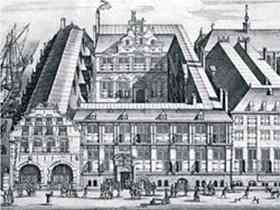In a matter of months, the government of the Netherlands will open a new building in the Dutch settlement in Ayutthaya. The building - the Dutch Information Centre - is touted as a gift that will cherish the long-standing friendship between the two nations. The Dutch Information Centre project, an extended activity to mark the 400th anniversary of Thai-Netherlands relations in 2004, received the go-ahead after cabinet approval in November 2009.
 The Dutch, who were employed by the legendary Dutch East India Company (Vereenigde Oost-Indische Compagnie, or VOC), were one of the first Europeans to come to the former capital of Siam to trade during the reign of King Ekatosrot in the early 1600s.
The Dutch, who were employed by the legendary Dutch East India Company (Vereenigde Oost-Indische Compagnie, or VOC), were one of the first Europeans to come to the former capital of Siam to trade during the reign of King Ekatosrot in the early 1600s.Like other foreigners in the Kingdom, they were allowed to settle in the area, which is now known as Khlong Suan Plu subdistrict on the banks of the Chao Phraya River. Not far from Wat Pananchoeng, the Dutch settlement was located next door to the British settlement and opposite the Portuguese settlement. However, it was abandoned after Ayutthaya fell to the Burmese army in 1777, left vacant, and later trespassed on in certain areas.
In 1938, the Fine Arts Department registered the Dutch settlement as an historical site. However, it took the department more than 60 years to restore the site to its former glory.
The first excavation was conducted in 2004 when the two countries celebrated the 400th anniversary of their friendship. HM Queen Beatrice, while on an official visit to Thailand in 2004, visited the settlement. The Fine Arts Department excavated the site again the following year but were forced to suspend further work being done due to a budget shortage.
 Though with financial and technical support from the Dutch Embassy the excavation resumed in 2008; this time it was carried out by a team of archaeologists from both countries. Methadol Wichakana, the head of the Ayutthaya Historical Park, said the Dutch Embassy helped to allocate 10 million baht to the project. After a sluggish start, the project made great progress, he noted. The excavation enabled archaeologists to locate the brick foundations of four concrete buildings.
Though with financial and technical support from the Dutch Embassy the excavation resumed in 2008; this time it was carried out by a team of archaeologists from both countries. Methadol Wichakana, the head of the Ayutthaya Historical Park, said the Dutch Embassy helped to allocate 10 million baht to the project. After a sluggish start, the project made great progress, he noted. The excavation enabled archaeologists to locate the brick foundations of four concrete buildings.One of the buildings, a two-storey structure, was the VOC's main office, and the rest included a warehouse, accommodation and a billiard hall building. Some antiquities, including an ancient VOC coin and remnants of a tobacco pipe, as well as Cheng Dynasty and Japanese ceramic bowls, were unearthed from the site.
According to Mr Methadol, the centre's design and structural blueprints were completed and the embassy was to choose a construction company to fill the job.
"It will be a two-storey, Western-style building," he said. Archaeologist Phattarapong Khao-ngern said the design of the Dutch Information Centre will be a replica of Dutch architectural structures of that era.
Such VOC buildings still remain in some of the countries that were occupied by the Netherlands, including Indonesia, where Jakarta served as the main trade centre for the VOC. Mr Phattarapong said it was clear that the VOC in Ayutthaya was smaller than the one in Jakarta, therefore the new settlement was also smaller in size.
"Unfortunately, a larger part of the current Dutch settlement in Ayutthaya was possessed by a private shipyard. The settlement, now measuring 1.3 rai [about 1,800m2], occupies only one tenth of the original plot," Mr Phattarapong said, and pointed out that the excavation work showed half of the main 12.5x45-metre building is within the settlement while the other half falls on the shipyard's premise.
"We thoroughly examined the part on our side but could not do much on the part that belongs to the shipyard company because it is private property," he added.
The archaeologist expressed hope that there will be a chance to further study the area occupied by the shipyard. Hans van Santen, a senior diplomat at the Netherlands Embassy, said a team of Thai-Dutch scholars was appointed to take care of these matters for the centre. Representatives in the Thai team included renowned historians Dhiravat na Pombejra and Bhawan Ruangsilp, who did his PhD study thesis on the East India Company in Siam.
 The Dutch side is led by Thailand expert Hans ten Brummelhuis. Mr van Santen said the centre was to deal straightforwardly with the role of Dutch traders in Ayutthaya in that period, adding that there was no intention to "glorify the Dutch role". Dhiravat na Pombejra said his contribution to the project is to draft a working paper and produce an outline of what historical material or explanations should or could be included in the centre; other contributions will come from Mr Bhawan and Mr ten Brummelhuis.
The Dutch side is led by Thailand expert Hans ten Brummelhuis. Mr van Santen said the centre was to deal straightforwardly with the role of Dutch traders in Ayutthaya in that period, adding that there was no intention to "glorify the Dutch role". Dhiravat na Pombejra said his contribution to the project is to draft a working paper and produce an outline of what historical material or explanations should or could be included in the centre; other contributions will come from Mr Bhawan and Mr ten Brummelhuis.The team is to meet some time soon to conclude the work, he said, adding that there was only one team meeting late last year. He said he looked forward to a new meeting to be called by the Fine Arts Department.
"My main objective is to explain not only the key events and facts in the Dutch East India Company's involvement in Siam [1604 to 1765], but to also provide appropriate historical contexts [Ayutthaya as a cosmopolitan, multicultural port city; the policies of both the VOC and the Siamese kings as regards with trade and diplomacy] and the continuity of Thai-Dutch relations up until the present," said Mr Dhiravat.
The historian also noted that the centre plans to make good use of Dutch historical documents. "Our intention is to present a rounded picture with proper historical contexts - not just another Thai-centric discourse." Mr Dhiravat said he hoped the centre would be of great benefit in stimulating more interest in Thai-Dutch relations, leading to more research and written works on the topic.
"It should also add to the body of knowledge about Ayutthaya available to the general public, including schoolchildren and tourists," renowned historian Charnvit Kasetsiri said of the project.
The historian, who proposed a re-excavation of the nearby Japanese settlement, said that previous archaeological works at the ancient settlements were too rough and more efforts should be made to re-examine them. He also said that such projects are significant as they add depth to the study of Ayutthaya, expanding it from palaces and temples.
Source: Bangkok Post [April 19, 2010]





